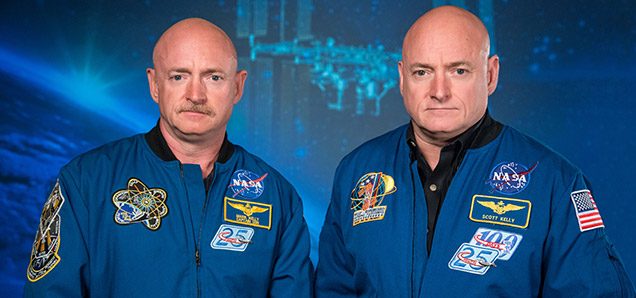One giant leap for twin brother astronauts
 CREDIT: NASA (CC BY-NC 2.0)
CREDIT: NASA (CC BY-NC 2.0)Scott and Mark Kelly are now the first set of twins to be used for scientific testing in space.
Humans began a new era of space exploration research on March 28, as astronaut Scott Kelly and cosmonaut Mikhail Korniyenko rose from the Baikonur Cosmodrome atop a Soyuz lifting body, beginning Expedition 43 – a 350-day (one-year) mission aboard the International Space Station (ISS), 400 km from Earth’s surface.
The pair was joined by cosmonaut Gennady Padalka on the flight up, who will stay aboard for six months, a usual stay aboard the ISS.
While humans have stayed in the planets orbit for longer periods, previous spaceflight records of 365, 380 and 438 days are held solely by cosmonauts, those missions occurred aboard Mir – Russia’s former space station – and happened before 2000. Adding to that is the fact that Russia and NASA’s last long-term human space study occurred in 2007, and it’s easy to understand the need for this mission.
The one-year mission is also unique for another reason. NASA veteran of 16 years, Scott Kelly is joined – on the ground – by his identical twin and astronaut Mark, who will act as a test control on Earth, monitoring what the longterm effects of living in microgravity will be, compared to a person’s average aging. The brothers – having the distinction of being the only siblings to have both been in space – are now also the first set of twins to be used for scientific testing in space as well.
The rigours of living beyond our atmosphere are already well documented, including vision impairment, blood vessel hardening and osteoporosis. With advances in science over the last two decades, we now understand that mental and microbial health are just as important as physical fitness. Despite this, few large-scale studies have been conducted. And while only having two people in Earth’s orbit for a year doesn’t seem like a large scale project, one needs to remember-the two scientists participating in this mission are 33 per cent of the crew aboard the ISS.
To put that in scale, 33 per cent of Fanshawe College’s student population is 5,000. Imagine 5,000 students participating in a single yearlong study. So while a duo isn’t a large scale on Earth, it’s still onethird the entire human population currently living in outer space.
During the one year mission all of these health issues will be monitored in preparation for the needs of NASA when it sends humans to Mars in 15 years. Preparations for NASA’s first human mission to Mars have ramped up over the six months, with the testing of two major rocket components: the Space Launch System, the most powerful rocket ever built and the Orion Multipurpose Crew Vehicle – a UFO-shaped capsule designed to replace NASA’s reliance on Roscosmos (the Russian space agency) for travelling to the ISS.
But it’s not just the one year mission that will ensure members aboard the ISS are busy. Crews have performed multiple spacewalks over the last two months, rerouting hundreds of metres of electrical cables, as new modules are to be added to the ISS’s compliment this year, including an expandable habitat by Bigelow Aerospace. There’s never a boring day on the ISS, especially when preparing humans for further space exploits.














